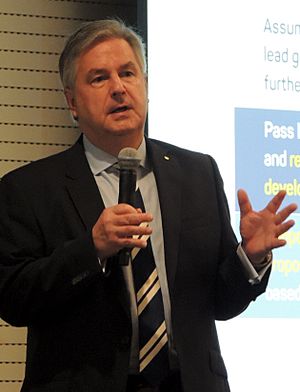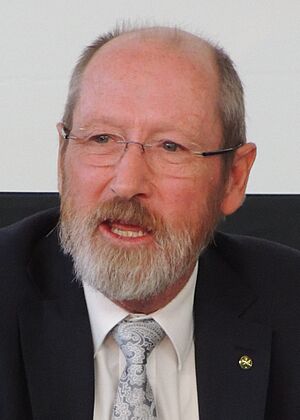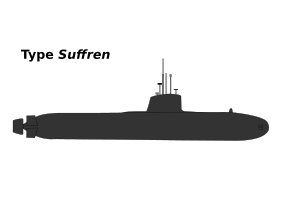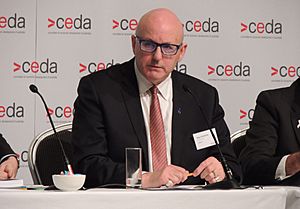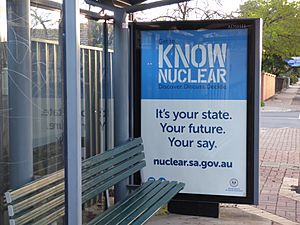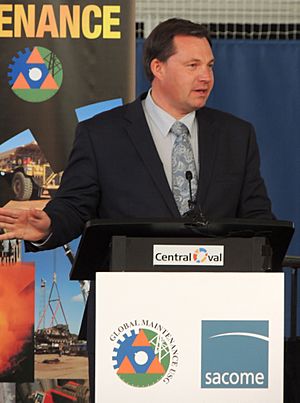Nuclear industry in South Australia facts for kids
The nuclear industry in South Australia mainly focuses on uranium mining. This involves digging up uranium, processing it, and then exporting it. This uranium is used to make fuel for nuclear power plants around the world. South Australia is special because it has the world's largest known single deposit of uranium at the Olympic Dam mine, which is operated by a company called BHP.
There are also some old sites in South Australia that are still contaminated. These include Maralinga and Emu Field, where nuclear weapons tests were carried out in the 1950s and 1960s. There are also contaminated spots at old uranium mines and processing sites. The CSIRO, a science organization, stores some nuclear waste at Woomera.
In 2016, a special group called the Nuclear Fuel Cycle Royal Commission suggested that South Australia should think about building a place to store nuclear waste, including used nuclear fuel. They also recommended removing laws that stop new nuclear developments in Australia.
In 2017, a location near Kimba on the Eyre Peninsula was chosen for Australia's national radioactive waste storage facility. This is where Australia's own nuclear waste would be kept. However, this choice has caused a lot of environmental conflict. The Barngarla people, who say this land is traditionally theirs, were not asked or included in the decision. Barngarla elders have even taken legal action to challenge the site selection.
Some important people, including former Prime Ministers from different political parties, have supported growing the nuclear industry in South Australia.
Contents
Uranium Mining in South Australia
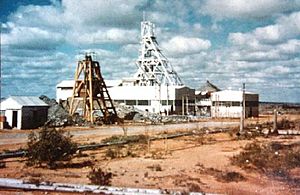
Uranium mining has been happening in South Australia since the early 1900s. Back then, people were looking for radium in uranium-rich rocks found at places like Radium Hill and Mount Painter.
During the Cold War, the government helped develop the Radium Hill uranium mine and a processing plant in Port Pirie. These closed in the early 1960s after they had supplied uranium for seven years.
In the 1970s, a huge amount of uranium was found near Roxby Downs. This led to the opening of the Olympic Dam mine in 1988. In the 2000s, new ways of mining, like in-situ leach mining, started at places like Beverley, Four Mile, and Honeymoon.
As of 2016, the Beverley and Honeymoon mines are not actively mining. They are in "care and maintenance" mode because uranium prices were low after the Fukushima Daiichi nuclear disaster in Japan.
Searching for uranium in South Australia reached its highest point in 2006, with forty companies looking for the mineral.
Exporting Uranium
Uranium mined in South Australia is sent overseas. It is used to make nuclear fuel for power plants that create electricity. In 2013, uranium from South Australia was sent to countries like Britain, France, Sweden, Finland, Belgium, Canada, and the United States.
In 2011, South Australian Premier Jay Weatherill supported sending uranium to India. This was despite India not signing the Nuclear Non-Proliferation Treaty, which aims to stop the spread of nuclear weapons. By December 2015, there were no longer any rules stopping this trade.
Storing Nuclear Waste
Nuclear waste is found in several places in South Australia. This includes the waste ponds at the Olympic Dam mine, the old Port Pirie uranium processing site, and the former Radium Hill mine. The CSIRO also runs a nuclear waste storage facility at Woomera in the far north of the state.
For many years, since the 1980s, there have been discussions about where to store Australia's radioactive waste safely.
Between 1998 and 2004, the Howard government tried to set up nuclear waste storage facilities in South Australia, but these attempts were not successful. This idea came up again during later governments from 2013 to 2022. Several sites on Aboriginal lands were suggested, but Indigenous people opposed them. They saw these proposals as a form of environmental racism, where harmful facilities are placed in their communities.
In 2016, the Nuclear Fuel Cycle Royal Commission made recommendations. This eventually led to a site near Kimba on the Eyre Peninsula being chosen for a national waste facility.
National Radioactive Waste Management Facility
The site chosen near Kimba has been challenged by the Barngarla people. They say the land is their traditional country and they were not asked or included in the decision to approve the facility. Barngarla elders have started legal challenges against the site choice.
Before the site at Napandee, near Kimba, was officially chosen for the National Radioactive Waste Management Facility, there was a seven-year process of discussions.
Some landowners offered their properties for the facility, but Indigenous people were not part of this process. The plan is to store Australia's own radioactive waste there. This includes waste from Australia's research reactors at Lucas Heights.
One possible site, Barndioota, was announced in 2015. This property was owned by Grant Chapman, and the traditional owners are the Adnyamathanha people. Two other possible sites were named near Kimba on the Eyre Peninsula.
The Kimba sites are in the area represented by Rowan Ramsey in the federal parliament. Ramsey publicly supported having nuclear waste storage facilities in South Australia. He even said he would be comfortable storing it on his own property. However, he did not offer his property because it would have been a conflict of interest. The people in Kimba have different opinions about the benefits and risks of having the facility there.
People who are against the new national facility believe that Australia's nuclear waste should be stored long-term at Lucas Heights. This is where much of the waste is created. Important opponents include Jim Green from Friends of the Earth Australia and David Sweeney from the Australian Conservation Foundation.
Storing Waste Deep Underground
Used nuclear fuel is considered very high-level nuclear waste. It needs to be kept completely separate from the environment, ideally in a facility built deep underground. Some people have wondered if nuclear waste could be stored in the underground tunnels of the Olympic Dam mine.
The Committee for Adelaide supported developing new nuclear waste storage facilities in South Australia in May 2016.
The Nuclear Fuel Cycle Royal Commission's final report, released in May 2016, suggested that South Australia should consider building a place to store imported used nuclear fuel. This would need deep, underground storage to keep the waste safe.
A group of everyday citizens, called a Citizens Jury, was asked to review the report. They voted not to go ahead with looking into importing used nuclear fuel for storage in South Australia. However, in December 2016, a group of well-known citizens signed an open letter. They asked South Australia's elected leaders to keep exploring this opportunity. They wanted more investigations to understand if the project was possible and to get more information from other countries.
In March 2017, it was estimated that $30 million would be needed to manage nuclear waste stored at Woomera. Barrels holding the waste were found to be rusting and getting old.
Nuclear Submarines
In 2021, the government announced that Australia would get a fleet of submarines powered by nuclear energy. This replaced an earlier plan to build diesel-powered submarines with a French company.
The idea of building nuclear submarines in South Australia had been discussed many times in the 2010s. In 2011, Andrew Fletcher, the CEO of Defence SA, thought it was unlikely Australia would build nuclear submarines unless a nuclear industry was already set up in Australia, or if they were built overseas. He believed that 12 diesel-powered submarines were more likely.
In 2016, a French company, Direction des Constructions Navales Services (DCNS), won the contract to supply Australia's future submarines. The French Barracuda-class submarine was chosen. This submarine is usually nuclear-powered, but the Australian government wanted a modified design that used diesel. Other companies competing for the contract did not make nuclear-powered submarines. Australian government ministers discussed keeping the nuclear option open by choosing the Barracuda-class design.
In 2017, former Australian Prime Minister Tony Abbott spoke about the benefits of nuclear power for Australia's future submarines. He said nuclear submarines would have advantages like longer range and greater speed compared to diesel ones.
In 2021, the AUKUS security agreement was signed between Australia, the US, and the UK. The agreement with the French was cancelled. Instead, Australia would develop a fleet of nuclear-powered submarines using American and British technology and knowledge. The new nuclear fleet will be designed with these AUKUS partners, and more details were expected in 2023.
Nuclear Weapons
A series of British nuclear weapons tests were carried out at Maralinga and Emu Field in the 1950s and early 1960s. Parts of these sites are still contaminated, and people are not allowed to access them.
Australia does not have its own nuclear weapons and cannot develop them. Australia is allied with countries that do have nuclear weapons. As of 2016, the Liberal-National Coalition political party did not support banning nuclear weapons. However, the Australian Labor Party and Australian Greens political parties did support a ban.
Future Possibilities
In 2015, the Government of South Australia started a Nuclear Fuel Cycle Royal Commission. This group was asked to look into the good and bad things about possibly expanding South Australia's role in the nuclear fuel cycle. Commissioner Kevin Scarce gave his final report in May 2016.
The report suggested removing laws that stop nuclear industrial development in Australia, including making nuclear power generation legal. It also recommended setting up a facility to store international stockpiles of spent nuclear fuel (used nuclear fuel). The report also mentioned a possible "nuclear fuel leasing" plan. This could allow for future activities like enrichment (making uranium more powerful) and fuel processing. However, these further processing developments were not expected to be possible within the next ten years. The report also said that building nuclear power plants in South Australia was not suitable right now because the state already uses a lot of solar and wind power.
2016–17 Community Discussions
The Government of South Australia set aside $3.6 million in 2016–17. This money was for the Department of the Premier and Cabinet to talk with the community. The goal was to help people understand the Nuclear Fuel Cycle Royal Commission's report and form their own opinions.
Citizens' Jury Process
After the Royal Commission finished, the Department of the Premier and Cabinet launched a website called "YourSAy nuclear?". They also ran an advertising campaign and started a "Citizens' Jury" process. The New Democracy Foundation managed this. They randomly invited 25,000 South Australians to take part by mail. From those who accepted, 350 jurors were chosen to meet and discuss the Royal Commission's report. They helped create a simpler version of the report for more discussion. In the end, they would say if they supported or rejected the recommendations.
The first Citizens' Jury had 50 people. They received the Royal Commission's report and heard from a group of experts.
| Member's name | Main job | Other connections |
|---|---|---|
| Jason Kuchel | CEO of South Australian Chamber of Mines & Energy | Member of Minerals and Energy Advisory Council |
| Simon Longstaff | Founder of The Ethics Centre | The Ethics Centre gets money from companies like BHP and Santos |
| Nigel McBride | CEO of Business SA | Member of the State Advisory Council for CEDA, former lawyer |
| Michael Penniment | Director of Radiation oncology at the Royal Adelaide Hospital | Works for the Government of South Australia |
| Leanna Read | Chief Scientist of SA | Member of Royal Commission committees, member of the Economic Development Board |
| Kelly-Anne Saffin | CEO of Northern and Yorke Regional Development Australia | RDA gets money from the Australian and South Australian Governments |
| Keith Thomas | CEO of SA Native Title Services | SA Native Title Services gets money from the Government of South Australia |
| Craig Wilkins | CEO of Conservation Council of South Australia | Former Chief of Staff for a Green party politician. The Conservation Council gets money from the Government of South Australia. |
The first Citizens' Jury wrote a report after listening to experts and discussing for four days. After this, a statewide community discussion program was launched. This campaign used the slogan "Get to know nuclear. Discover. Discuss. Decide." It included ads on TV, radio, and in print, as well as online discussions and community displays.
A second jury was later formed, with about 350 people.
After hearing from even more experts, the Citizens' Jury finally decided, by a two-thirds vote, not to pursue the idea of importing used nuclear fuel to South Australia. They said a "lack of trust" was a main reason for their decision.
Support for Expansion
Many groups and individuals have supported expanding the nuclear industry in South Australia. These include uranium mining companies like Western Mining Corporation, BHP, and Rio Tinto. Industry groups like the Minerals Council of Australia have also shown support. Other supporters include Richard Yeeles, Nigel McBride from Business SA, and Jason Kuchel from the South Australian Chamber of Mines & Energy. Some experts from UCL Australia have also published research supporting more nuclear development in South Australia. Professor Stefaan Simons has suggested looking into uranium enrichment and nuclear-powered submarines.
In March 2017, eleven members of the government openly supported the idea of nuclear power in Australia. These politicians included Andrew Broad, James Paterson, Tony Pasin, Tim Wilson, Chris Back, Craig Kelly, Eric Abetz, Andrew Hastie, Warren Entsch, Bridget McKenzie, and Rowan Ramsey. In June 2017, former Prime Minister Tony Abbott noted that former Prime Minister Bob Hawke also supported expanding the nuclear industry. Abbott suggested that the South Australian government might want to develop new industries, like a nuclear submarine servicing facility, to go along with the uranium mine at Roxby Downs.
Opposition to Expansion
For many decades, there has been strong opposition in Australia to uranium mining. People have concerns that uranium helps create nuclear weapons, harms or damages sacred sites, releases dangerous radon gas, and contaminates groundwater. Opponents also see nuclear power as unsafe, too centralized, and secretive, creating security risks. Managing high-level radioactive waste has also been a major worry.
Groups against expanding the nuclear industry in South Australia include the Australian Greens (with spokespeople like Scott Ludlam and Mark Parnell), Friends of the Earth, the Australian Conservation Foundation, and the Conservation Council of South Australia. Opposition has also come from Indigenous elders like Kevin Buzzacott, Eileen Kampakuta Brown, and Eileen Wani Wingfield. Protest groups have organized events at the Olympic Dam mine gates in 2012 and 2016.


